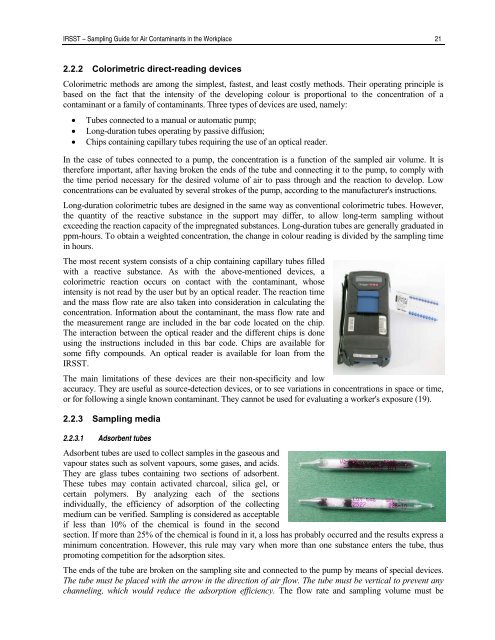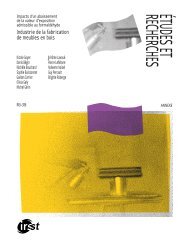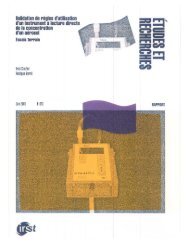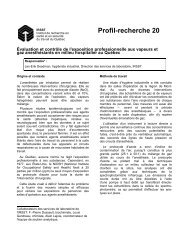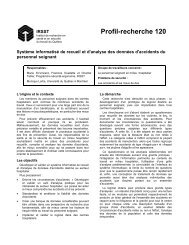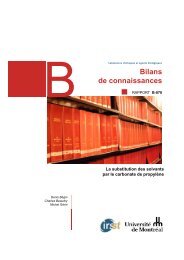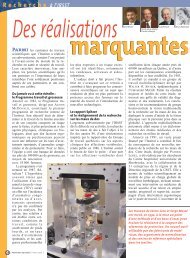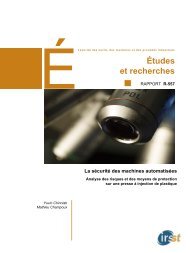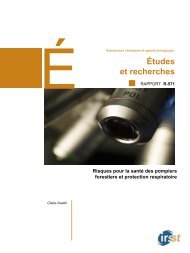Sampling Guide for Air Contaminants in the Workplace - Irsst
Sampling Guide for Air Contaminants in the Workplace - Irsst
Sampling Guide for Air Contaminants in the Workplace - Irsst
Create successful ePaper yourself
Turn your PDF publications into a flip-book with our unique Google optimized e-Paper software.
IRSST – <strong>Sampl<strong>in</strong>g</strong> <strong>Guide</strong> <strong>for</strong> <strong>Air</strong> <strong>Contam<strong>in</strong>ants</strong> <strong>in</strong> <strong>the</strong> <strong>Workplace</strong> 21<br />
2.2.2 Colorimetric direct-read<strong>in</strong>g devices<br />
Colorimetric methods are among <strong>the</strong> simplest, fastest, and least costly methods. Their operat<strong>in</strong>g pr<strong>in</strong>ciple is<br />
based on <strong>the</strong> fact that <strong>the</strong> <strong>in</strong>tensity of <strong>the</strong> develop<strong>in</strong>g colour is proportional to <strong>the</strong> concentration of a<br />
contam<strong>in</strong>ant or a family of contam<strong>in</strong>ants. Three types of devices are used, namely:<br />
• Tubes connected to a manual or automatic pump;<br />
• Long-duration tubes operat<strong>in</strong>g by passive diffusion;<br />
• Chips conta<strong>in</strong><strong>in</strong>g capillary tubes requir<strong>in</strong>g <strong>the</strong> use of an optical reader.<br />
In <strong>the</strong> case of tubes connected to a pump, <strong>the</strong> concentration is a function of <strong>the</strong> sampled air volume. It is<br />
<strong>the</strong>re<strong>for</strong>e important, after hav<strong>in</strong>g broken <strong>the</strong> ends of <strong>the</strong> tube and connect<strong>in</strong>g it to <strong>the</strong> pump, to comply with<br />
<strong>the</strong> time period necessary <strong>for</strong> <strong>the</strong> desired volume of air to pass through and <strong>the</strong> reaction to develop. Low<br />
concentrations can be evaluated by several strokes of <strong>the</strong> pump, accord<strong>in</strong>g to <strong>the</strong> manufacturer's <strong>in</strong>structions.<br />
Long-duration colorimetric tubes are designed <strong>in</strong> <strong>the</strong> same way as conventional colorimetric tubes. However,<br />
<strong>the</strong> quantity of <strong>the</strong> reactive substance <strong>in</strong> <strong>the</strong> support may differ, to allow long-term sampl<strong>in</strong>g without<br />
exceed<strong>in</strong>g <strong>the</strong> reaction capacity of <strong>the</strong> impregnated substances. Long-duration tubes are generally graduated <strong>in</strong><br />
ppm-hours. To obta<strong>in</strong> a weighted concentration, <strong>the</strong> change <strong>in</strong> colour read<strong>in</strong>g is divided by <strong>the</strong> sampl<strong>in</strong>g time<br />
<strong>in</strong> hours.<br />
The most recent system consists of a chip conta<strong>in</strong><strong>in</strong>g capillary tubes filled<br />
with a reactive substance. As with <strong>the</strong> above-mentioned devices, a<br />
colorimetric reaction occurs on contact with <strong>the</strong> contam<strong>in</strong>ant, whose<br />
<strong>in</strong>tensity is not read by <strong>the</strong> user but by an optical reader. The reaction time<br />
and <strong>the</strong> mass flow rate are also taken <strong>in</strong>to consideration <strong>in</strong> calculat<strong>in</strong>g <strong>the</strong><br />
concentration. In<strong>for</strong>mation about <strong>the</strong> contam<strong>in</strong>ant, <strong>the</strong> mass flow rate and<br />
<strong>the</strong> measurement range are <strong>in</strong>cluded <strong>in</strong> <strong>the</strong> bar code located on <strong>the</strong> chip.<br />
The <strong>in</strong>teraction between <strong>the</strong> optical reader and <strong>the</strong> different chips is done<br />
us<strong>in</strong>g <strong>the</strong> <strong>in</strong>structions <strong>in</strong>cluded <strong>in</strong> this bar code. Chips are available <strong>for</strong><br />
some fifty compounds. An optical reader is available <strong>for</strong> loan from <strong>the</strong><br />
IRSST.<br />
The ma<strong>in</strong> limitations of <strong>the</strong>se devices are <strong>the</strong>ir non-specificity and low<br />
accuracy. They are useful as source-detection devices, or to see variations <strong>in</strong> concentrations <strong>in</strong> space or time,<br />
or <strong>for</strong> follow<strong>in</strong>g a s<strong>in</strong>gle known contam<strong>in</strong>ant. They cannot be used <strong>for</strong> evaluat<strong>in</strong>g a worker's exposure (19).<br />
2.2.3 <strong>Sampl<strong>in</strong>g</strong> media<br />
2.2.3.1 Adsorbent tubes<br />
Adsorbent tubes are used to collect samples <strong>in</strong> <strong>the</strong> gaseous and<br />
vapour states such as solvent vapours, some gases, and acids.<br />
They are glass tubes conta<strong>in</strong><strong>in</strong>g two sections of adsorbent.<br />
These tubes may conta<strong>in</strong> activated charcoal, silica gel, or<br />
certa<strong>in</strong> polymers. By analyz<strong>in</strong>g each of <strong>the</strong> sections<br />
<strong>in</strong>dividually, <strong>the</strong> efficiency of adsorption of <strong>the</strong> collect<strong>in</strong>g<br />
medium can be verified. <strong>Sampl<strong>in</strong>g</strong> is considered as acceptable<br />
if less than 10% of <strong>the</strong> chemical is found <strong>in</strong> <strong>the</strong> second<br />
section. If more than 25% of <strong>the</strong> chemical is found <strong>in</strong> it, a loss has probably occurred and <strong>the</strong> results express a<br />
m<strong>in</strong>imum concentration. However, this rule may vary when more than one substance enters <strong>the</strong> tube, thus<br />
promot<strong>in</strong>g competition <strong>for</strong> <strong>the</strong> adsorption sites.<br />
The ends of <strong>the</strong> tube are broken on <strong>the</strong> sampl<strong>in</strong>g site and connected to <strong>the</strong> pump by means of special devices.<br />
The tube must be placed with <strong>the</strong> arrow <strong>in</strong> <strong>the</strong> direction of air flow. The tube must be vertical to prevent any<br />
channel<strong>in</strong>g, which would reduce <strong>the</strong> adsorption efficiency. The flow rate and sampl<strong>in</strong>g volume must be


